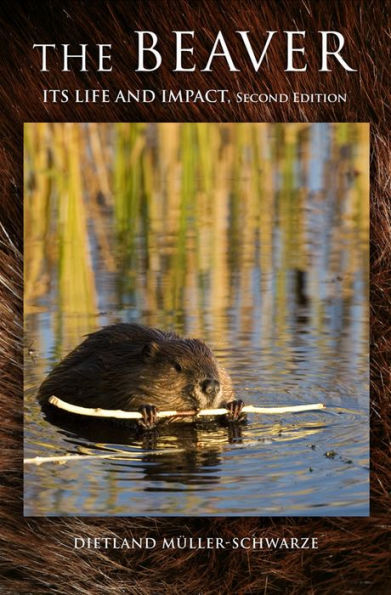
The Beaver: Natural History of a Wetlands Engineer
192
The Beaver: Natural History of a Wetlands Engineer
192Hardcover(Second Edition)
-
PICK UP IN STORECheck Availability at Nearby Stores
Available within 2 business hours
Related collections and offers
Overview
In an up-to-date, exhaustively illustrated, and comprehensive book on beaver biology and management, Dietland Müller-Schwarze gathers a wealth of scientific knowledge about both the North American and Eurasian beaver species. The Beaver is designed to satisfy the curiosity and answer the questions of anyone with an interest in these animals, from students who enjoy watching beaver ponds at nature centers to homeowners who hope to protect their landscaping. Photographs taken by the authors document every aspect of beaver behavior and biology, the variety of their constructions, and the habitats that depend on their presence.
Beaver facts:
•Just as individual beavers shape their immediate surroundings, so did the distribution of beavers across North America influence the paths of English and French explorers and traders. As a result of the fur trade, beavers were wiped out across large areas of the United States. Reintroduction efforts led to the widespread establishment of these resilient animals, and now they are found throughout North America, Europe, and parts of the southern hemisphere.
•Beaver meadows provided early settlers with level, fertile pastures and hayfields.
•Based on the fossil record, the smallest extinct beaver species were the size of a muskrat, and the largest may have reached the size of a black bear (five to six times as large as today's North American beavers). Beaver-gnawed wood has been found alongside the skeleton of a mastodon.
•Some beavers remain in the home lodge for an extra year to assist their parents in raising younger siblings. They feed, groom, and guard the newborn kits.
•In 1600, beaver ponds covered eleven percent of the upper Mississippi and Missouri Rivers' watershed above Thebes, Illinois. Restoring only 3 percent of the original wetlands might suffice to prevent catastrophic floods such as those in the early 1990s.

Product Details
| ISBN-13: | 9780801450105 |
|---|---|
| Publisher: | Cornell University Press |
| Publication date: | 04/07/2011 |
| Edition description: | Second Edition |
| Pages: | 192 |
| Sales rank: | 580,673 |
| Product dimensions: | 6.30(w) x 9.30(h) x 1.10(d) |
| Age Range: | 18 Years |
About the Author
Table of Contents
Preface vii
Introduction xi
Part I The Organism
1 Now and Then: The Species, Including Fossils 2
2 Form, Weight, and Special Adaptations 11
3 Diving and Thermoregulation: From Land Mammal to Semiaquatic Design and Function 19
4 Energy Budget 24
Part II Behavior
5 Families as Social Units 30
6 Communication by Scent and Sound 39
7 Infrastructure: Dams, Lodges, Trails, and Canals 55
8 Beaver Time 64
9 Food Selection 68
Part III Populations
10 Reproduction, Development, and Life Expectancy 88
11 Population Densities and Dynamics 97
12 Finding a Home: Dispersal 110
Part IV Ecology
13 Where They Live and Why: Habitat Requirements 116
14 Mortality and Predators 123
15 Parasites and Diseases 129
16 Maker of Landscapes: Creating Habitat for Plants, Animals, and People 135
Part V Beaver and People: Conservation, Use, and Management
17 "Here before Christ": Fur Trade, the "Beaver Republic" (Hudson's Bay Company), and Fur Trapping Today 150
18 Reintroductions and Other Transplants 169
19 "Nuisance Beavers" Claim Their Land 178
20 Needed: An Ecosystems Engineer for Habitat Restoration and Other Services 184
21 Living with Beavers: Conservation and Proactive Management 191
Index 205
What People are Saying About This
"Beavers are keystone animals who have played a large role in shaping the American biosphere. They also drew the American map by luring the trappers and mountainmen into the wilderness, and so promoting westward expansion. Although once nearly eradicated because of a frivolous fashion for men's hats, they are now making a dramatic comeback. Their behavior and ecology are perhaps more familiar than those of any other of our native mammal species, yet no comprehensive and up-to-date modern scientific treatise about the beaver has been available. This concise yet comprehensive book fills a glaring gap in the literature about one of the most interesting and important species in the northern ecosystem."
"Revered by naturalists, loved by children, and dreaded by golf course maintenance crews, the North American beaver is a charismatic, often controversial symbol of wildlife's resurgence in the human-altered landscape. For anyone keen to learn more about this species, this book is an excellent reference."
"The Beaver is a modern synthesis of the beaver's ecology. It is a pleasure to read. The prose is easy to follow, as is the logic, and the insights about the beaver's biology are enlightening. This book is most suitable for a broad audience and ought to enjoy a great following. For the technical reader there is a good reference section following each chapter, as there needs to be, since the book goes beyond natural history and also deals with contentious management issues. It is thus more than an introduction to an animal that played a very great role in the history of North America. This synthesis also poses challenges for the future. This book should not be missing from a wildlife manager's book shelf."
"This book is a wonderful blend of natural and social history that satisfies all appetites in explaining the role and significance of beaver in contemporary landscapes. It is full of useful and relevant information about the return of nature's second best engineer and gives us a blueprint as to how we might work with these engaging animals to produce healthier and environmentally more sound environments, even in urban and suburban areas. I know of no better current source of information from which to learn about beaver and their ways as well as appreciate the complex history and relationship of people with these amazing animals."
